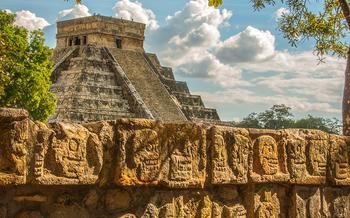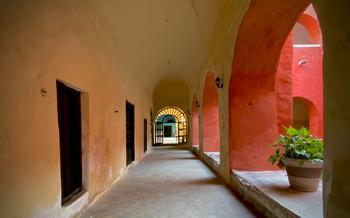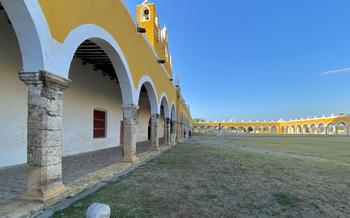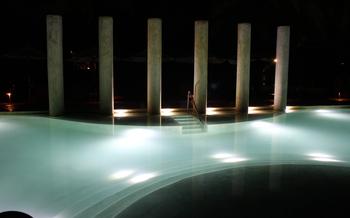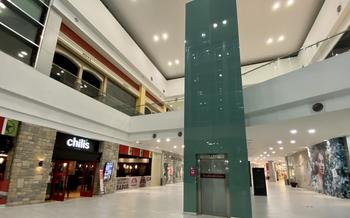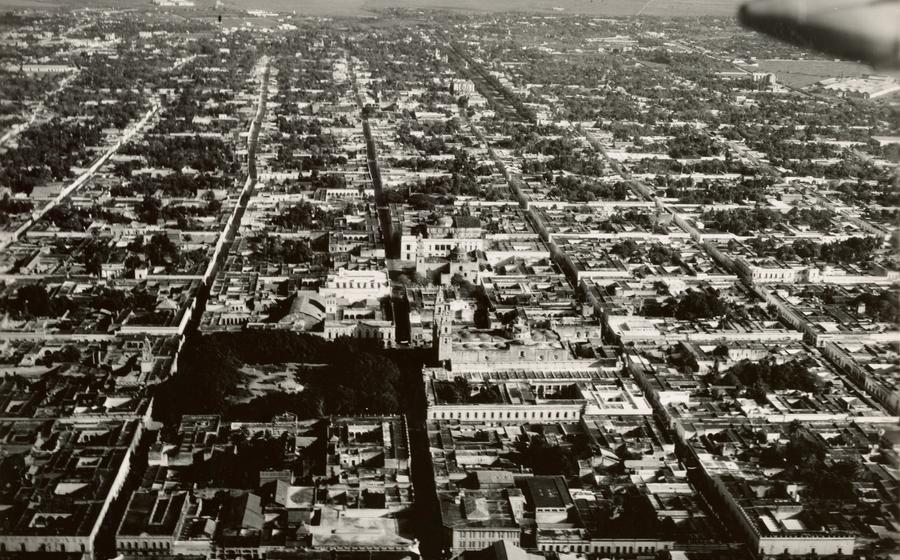
Cenote Bolonchoojol
- The Wonder of Cenote Bolonchoojol
- Swimming and Snorkeling: A Dive into Crystal-Clear Paradise
- Photography and Videography
- Cultural Significance
- Local Cuisine and Dining
- Nearby Attractions and Activities: A World Beyond the Cenote
- History and Legends
- Conservation and Sustainability
- Accessibility for All
- Insider Tip:
The Wonder of Cenote Bolonchoojol
In the heart of the Yucatan Peninsula, amidst lush vegetation and ancient Mayan ruins, lies a natural wonder that has captivated hearts for centuries: Cenote Bolonchoojol. Its name, derived from the Mayan language, translates to "nine openings," a reference to the nine entrances that lead to its crystal-clear waters.
Bolonchoojol is a testament to the unique geological formations found in the region. The cenote's waters are fed by a network of underground rivers that have carved intricate tunnels and chambers within the limestone bedrock, creating a mesmerizing underwater labyrinth. The cenote's crystal-clear waters offer unparalleled visibility, revealing an abundance of aquatic life, including colorful fish, turtles, and aquatic plants.
Cenotes hold a sacred place in Mayan culture, believed to be portals to the underworld and a source of life and renewal. The ancient Mayans used cenotes for various purposes, including religious ceremonies, water purification, and bathing. Today, Cenote Bolonchoojol continues to attract visitors from around the world who come to marvel at its natural beauty and immerse themselves in its refreshing waters.
Preserving and protecting Cenote Bolonchoojol and its delicate ecosystem is of paramount importance. Visitors are encouraged to practice responsible tourism by respecting the environment, avoiding littering, and using eco-friendly products. By working together, we can ensure that future generations can continue to enjoy the wonder and magic of this natural treasure.
Swimming and Snorkeling: A Dive into Crystal-Clear Paradise
Cenote Bolonchoojol offers an unparalleled swimming and snorkeling experience, inviting you to immerse yourself in its crystal-clear waters and discover a vibrant underwater world. The cenote's calm and shallow waters are ideal for both beginners and experienced swimmers, allowing you to glide effortlessly through its depths. As you dive beneath the surface, you'll be greeted by a mesmerizing spectacle of marine life, including colorful fish, graceful turtles, and a variety of aquatic plants that sway gently with the current.
Snorkeling in Cenote Bolonchoojol is a must-do activity, as it allows you to witness the incredible biodiversity that thrives within its depths. The cenote's crystal-clear waters provide exceptional visibility, enabling you to observe the intricate details of the underwater ecosystem. From vibrant coral formations to playful fish darting in and out of crevices, every glimpse into the cenote's depths reveals a new wonder.
For those seeking a more adventurous experience, Cenote Bolonchoojol also offers designated areas for diving. With its clear waters and diverse underwater topography, the cenote is a haven for experienced divers. Explore hidden caverns, swim through narrow passages, and encounter unique rock formations that create a breathtaking underwater landscape.
Whether you're a seasoned swimmer, a snorkeling enthusiast, or an adventurous diver, Cenote Bolonchoojol promises an unforgettable experience that will leave you in awe of its natural beauty and biodiversity.
Photography and Videography
Cenote Bolonchoojol offers a paradise for photographers and videographers, with its stunning natural beauty and crystal-clear waters. The vibrant colors and unique formations create a picturesque backdrop for capturing breathtaking images. The best time to visit for photography is during the early morning or late afternoon, when the sunlight illuminates the cenote and creates a magical glow.
When taking photos underwater, it's essential to use a waterproof camera or housing to protect your equipment. Experiment with different camera settings to achieve the desired effect, adjusting the ISO, shutter speed, and aperture to capture the perfect shot. A wide-angle lens is recommended for capturing the vastness of the cenote and its surroundings.
For videographers, Cenote Bolonchoojol provides an excellent opportunity to create captivating footage of the underwater world. Capture the graceful movements of fish, the gentle swaying of aquatic plants, and the mesmerizing reflections of sunlight on the water's surface. Utilize a stabilizer or tripod to ensure smooth and steady shots.
Remember to respect the natural environment and avoid disturbing the wildlife while taking photos or videos. Minimize the use of flash photography to prevent startling the animals and disrupting their behavior. Embrace the opportunity to showcase the beauty of Cenote Bolonchoojol while preserving its delicate ecosystem.
Cultural Significance
Cenote Bolonchoojol holds a deep cultural and spiritual significance for the ancient Mayans, who revered cenotes as sacred portals to the underworld. According to Mayan mythology, cenotes were believed to be the entrances to Xibalba, the Mayan realm of the dead. It was through these portals that the gods and ancestors communicated with the living world.
Cenotes were also considered to be sources of life and fertility, and were often used for religious ceremonies and rituals. Offerings were made to the gods in the form of precious objects, food, and even human sacrifices. Evidence of these offerings has been found in many cenotes, including Bolonchoojol, where archaeologists have discovered ceramic vessels, jewelry, and skeletal remains.
The Mayans also believed that cenotes had healing properties, and would often bathe in their waters to cure illnesses or to seek spiritual purification. The crystal-clear waters of Bolonchoojol were said to have particularly potent healing powers, and were believed to be able to cure everything from skin diseases to infertility.
To this day, Cenote Bolonchoojol remains a sacred site for many Maya people, who continue to visit the cenote to pray, meditate, and make offerings to their ancestors.
Local Cuisine and Dining
After a refreshing swim or dive in Cenote Bolonchoojol, indulge in the delectable flavors of Yucatecan cuisine. The region is renowned for its rich culinary traditions, so take the opportunity to savor some of its signature dishes.
Stroll through the nearby town or village to find local restaurants or eateries that offer authentic Yucatecan fare. Ask the locals for their recommendations or look for places that are frequented by the community.
One must-try dish is cochinita pibil, a slow-roasted pork dish marinated in achiote paste and wrapped in banana leaves. The result is tender, flavorful meat that melts in your mouth.
Another local favorite is panuchos, a thick tortilla topped with refried beans, shredded turkey or chicken, and pickled onions. Salbutes, another popular snack, are similar to panuchos but have a crispy fried tortilla base.
Don't forget to sample the local beverages, such as horchata, a refreshing rice-based drink, or fresh fruit juices made with tropical fruits like papaya, mango, and pineapple.
For a more immersive experience, visit a local market or food stall to purchase fresh fruits, vegetables, and snacks. You'll find an array of colorful and exotic produce, as well as traditional Yucatecan delicacies.
Indulge in the culinary delights of the region and discover the vibrant flavors that make Yucatecan cuisine so special. Whether you're dining at a local restaurant or savoring street food from a market stall, you're sure to have a memorable culinary experience.
Nearby Attractions and Activities: A World Beyond the Cenote
Beyond the enchanting depths of Cenote Bolonchoojol, the surrounding region beckons with a plethora of hidden gems. Immerse yourself in the rich history and culture of the ancient Maya at nearby archaeological sites like Chichén Itzá or Uxmal. Marvel at the colonial architecture and vibrant street life of charming towns like Valladolid or Izamal. Escape into the lush embrace of nature at nearby cenotes, such as Cenote Xkeken or Cenote Samulá, each offering its own unique charm and allure.
For a taste of local life, venture into the bustling markets of nearby towns, where you can haggle for souvenirs, savor fresh tropical fruits, and indulge in the tantalizing aromas of traditional Yucatecan cuisine. Don't miss the opportunity to witness the vibrant colors and infectious energy of local festivals, where you can join in the dancing, music, and celebrations that showcase the rich cultural heritage of the region.
Whether you seek adventure, relaxation, or cultural immersion, the area surrounding Cenote Bolonchoojol promises an unforgettable journey. Craft your itinerary to include a harmonious blend of natural wonders, historical landmarks, and authentic cultural experiences, ensuring a well-rounded and truly immersive exploration of this captivating region.
History and Legends
Cenote Bolonchoojol holds a rich tapestry of history and legends that have been passed down through generations. According to Mayan folklore, the cenote was once a sacred place where the gods descended to Earth. It is said that the name Bolonchoojol, which means "nine wells" in Mayan, refers to the nine openings or entrances that lead to the underworld.
In the 16th century, Spanish conquistadors arrived in the region and were amazed by the beauty and mystery of the cenote. They believed that it was a bottomless pit leading to the center of the Earth. Over the centuries, the cenote has attracted explorers, scientists, and adventurers from around the world, each seeking to unravel its secrets.
Archaeological excavations conducted at the cenote have revealed evidence of ancient Mayan settlements and rituals. Ceramic fragments, stone tools, and skeletal remains have been discovered, suggesting that the cenote was used for religious ceremonies and offerings. Mayan priests and shamans are believed to have performed rituals and communicated with the gods through the cenote's waters.
Today, Cenote Bolonchoojol continues to captivate visitors with its mystical atmosphere and rich history. Visitors can immerse themselves in the legends and stories that surround the cenote, creating a truly unforgettable experience.
Conservation and Sustainability
Cenote Bolonchoojol, like many other natural wonders, faces the challenges of conservation and sustainability. The increasing popularity of the cenote among tourists and locals poses a risk to its delicate ecosystem. To address this, several conservation efforts and initiatives are underway.
The local community, in collaboration with environmental organizations, has implemented strict regulations to protect the cenote. These include limiting the number of visitors allowed per day, enforcing a strict no-trash policy, and prohibiting the use of chemicals or harmful substances in the water.
Additionally, ongoing research and monitoring are conducted to assess the impact of tourism on the cenote's environment. Scientists study water quality, biodiversity, and the overall health of the ecosystem to ensure that conservation measures are effective.
As visitors, we have a responsibility to minimize our impact on the cenote. By following the established rules, respecting the natural environment, and supporting sustainable tourism practices, we can contribute to the preservation of this unique and fragile ecosystem.
Let's be mindful travelers and leave nothing but footprints at Cenote Bolonchoojol, allowing future generations to experience its pristine beauty and wonder.
Accessibility for All
Cenote Bolonchoojol is committed to providing an inclusive and enjoyable experience for visitors with disabilities or special needs. The cenote features several accessibility features to ensure that everyone can fully appreciate its natural beauty. Ramps and handrails have been installed to facilitate easy access to the cenote's platforms and swimming areas. Adapted restrooms are also available for the convenience of visitors with mobility challenges.
In addition, the cenote staff is trained to assist visitors with disabilities and provide any necessary support. Visitors are encouraged to reach out to the staff if they require any assistance or have any specific needs. Together, we can create a welcoming and accessible environment where everyone can immerse themselves in the wonders of Cenote Bolonchoojol.
Here are some tips to make the cenote more accessible for people with different abilities:
- Visitors with mobility impairments can rent wheelchairs or use their own wheelchairs to navigate the cenote's paths and platforms.
- Life jackets and flotation devices are available for those who need assistance with swimming or staying afloat.
- Visitors with visual impairments can request assistance from the staff for guidance and orientation within the cenote.
- Visitors with hearing impairments can utilize sign language interpreters or written communication to communicate with the staff and other visitors.
By embracing inclusivity and accessibility, Cenote Bolonchoojol ensures that everyone has the opportunity to experience the beauty and tranquility of this natural wonder.
Insider Tip:
Unleash your inner explorer and venture off the beaten path to discover a hidden gem within Cenote Bolonchoojol. Tucked away from the main swimming area, a secluded chamber awaits those seeking tranquility and a deeper connection with nature. Immerse yourself in the crystal-clear waters, surrounded by towering rock formations that create a cathedral-like ambiance. This secret spot is perfect for meditation, reflection, or simply soaking in the serenity of the cenote. Remember to tread lightly and respect the delicate ecosystem as you explore this hidden treasure.

